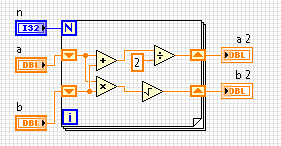26
1
This question was inspired by this HNQ.
About the series
This question is now part of a series about the AGM method. This first post in the series will be about actually calculating the AGM. You may treat this like any other code golf challenge, and answer it without worrying about the series at all. However, there is a leaderboard across all challenges.
What is the Arithmetic–Geometric Mean
The Arithmetic–Geometric Mean of two numbers is defined as the number that repeatedly taking the arithmetic and geometric means converges to. Your task is to find this number after some n iterations.
Clarifications
- You take three numbers,
a, b, nin any reasonable format. - For
niterations, take the arithmetic and geometric mean ofaandband set those toaandb. - For two numbers
aandb, the arithmetic mean is defined as(a + b) / 2. - The geometric mean is defined as
√(a * b). aandbshould be approaching each other.- Then, output both
aandb. - You don't have to worry about float imprecision and such.
- This is code-golf so shortest code in bytes wins!
Test Cases
[0, [24, 6]] -> [24, 6]
[1, [24, 6]] -> [15.0, 12.0]
[2, [24, 6]] -> [13.5, 13.416407864998739]
[5, [24, 6]] -> [13.458171481725616, 13.458171481725616]
[10, [100, 50]] -> [72.83955155234534, 72.83955155234534]
The next one is 1/Gauss's Constant:
[10, [1, 1.41421356237]] -> [1.198140234734168, 1.1981402347341683]
Leaderboard
Stolen from Martin's series.
The following snippet will generate a leaderboard across all challenges of the series.
To make sure that your answers show up, please start every answer with a headline, using the following Markdown template:
# Language Name, N bytes
where N is the size of your submission. If you improve your score, you can keep old scores in the headline, by striking them through. For instance:
# Ruby, <s>104</s> <s>101</s> 96 bytes
/* Configuration */
var QUESTION_IDs = [66068]; // Obtain this from the url
// It will be like http://XYZ.stackexchange.com/questions/QUESTION_ID/... on any question page
var ANSWER_FILTER = "!.FjwQBrX2KXuFkv6p2lChi_RjzM19";
/* App */
var answers = [], page = 1, currentQ = -1;
function answersUrl(index) {
return "http://api.stackexchange.com/2.2/questions/" + QUESTION_IDs.join(";") + "/answers?page=" + index + "&pagesize=100&order=desc&sort=creation&site=codegolf&filter=" + ANSWER_FILTER;
}
function getAnswers() {
$.ajax({
url: answersUrl(page++),
method: "get",
dataType: "jsonp",
crossDomain: true,
success: function (data) {
answers.push.apply(answers, data.items);
if (data.has_more) getAnswers();
else process();
}
});
}
getAnswers();
var SIZE_REG = /\d+(?=[^\d&]*(?:<(?:s>((?!>).)*<\/s>|((?!>).)+>)[^\d&]*)*$)/;
var NUMBER_REG = /\d+/;
var LANGUAGE_REG = /^#*\s*([^\n,]+)(?=,)/;//
function shouldHaveHeading(a) {
var pass = false;
var lines = a.body_markdown.split("\n");
try {
pass |= /^#/.test(a.body_markdown);
pass |= ["-", "="]
.indexOf(lines[1][0]) > -1;
pass &= LANGUAGE_REG.test(a.body_markdown);
} catch (ex) {}
return pass;
}
function shouldHaveScore(a) {
var pass = false;
try {
pass |= SIZE_REG.test(a.body_markdown.split("\n")[0]);
} catch (ex) {}
if (!pass) console.log(a);
return pass;
}
function getAuthorName(a) {
return a.owner.display_name;
}
function getAuthorId(a) {
return a.owner.user_id;
}
function process() {
answers = answers.filter(shouldHaveScore)
.filter(shouldHaveHeading);
answers.sort(function (a, b) {
var aB = +(a.body_markdown.split("\n")[0].match(SIZE_REG) || [Infinity])[0],
bB = +(b.body_markdown.split("\n")[0].match(SIZE_REG) || [Infinity])[0];
return aB - bB
});
var users = {};
answers.forEach(function (a) {
var headline = a.body_markdown.split("\n")[0];
var question = QUESTION_IDs.indexOf(a.question_id);
var size = parseInt((headline.match(SIZE_REG)||[0])[0]);
var language = headline.match(LANGUAGE_REG)[1];
var user = getAuthorName(a);
var userId = getAuthorId(a);
if (!users[userId]) users[userId] = {name: user, nAnswer: 0, answers: []};
if (!users[userId].answers[question]) {
users[userId].answers[question] = {size: Infinity};
users[userId].nAnswer++;
}
if (users[userId].answers[question].size > size) {
users[userId].answers[question] = {size: size, link: a.share_link}
}
});
var sortedUsers = [];
for (var userId in users)
if (users.hasOwnProperty(userId)) {
var user = users[userId];
user.score = 0;
user.completedAll = true;
for (var i = 0; i < QUESTION_IDs.length; ++i) {
if (user.answers[i])
user.score += user.answers[i].size;
else
user.completedAll = false;
}
sortedUsers.push(user);
}
sortedUsers.sort(function (a, b) {
if (a.nAnswer > b.nAnswer) return -1;
if (b.nAnswer > a.nAnswer) return 1;
return a.score - b.score;
});
var place = 1;
for (var i = 0; i < sortedUsers.length; ++i) {
var user = sortedUsers[i];
var row = '<tr><td>'+ place++ +'.</td><td>'+user.name+'</td>';
for (var j = 0; j < QUESTION_IDs.length; ++j) {
var answer = user.answers[j];
if (answer)
row += '<td><a href="'+answer.link+'">'+answer.size+'</a></td>';
else
row += '<td class="missing"></td>';
}
row += '<td></td>';
if (user.completedAll)
row += '<td class="total">'+user.score+'</td>';
else
row += '<td class="total missing">'+user.score+'</td>';
row += '</tr>';
$("#users").append(row);
}
}body { text-align: left !important}
#leaderboard {
width: 500px;
}
#answer-list {
padding: 10px;
width: 290px;
float: left;
}
#language-list {
padding: 10px;
width: 290px;
float: left;
}
table thead {
font-weight: bold;
}
table td {
padding: 5px;
}
td.total {
font-weight: bold;
text-align: right;
}
td.missing {
background: #bbbbbb;
}<script src="https://ajax.googleapis.com/ajax/libs/jquery/2.1.1/jquery.min.js"></script>
<link rel="stylesheet" type="text/css" href="//cdn.sstatic.net/codegolf/all.css?v=83c949450c8b">
<div id="leaderboard">
<h2>Leaderboard</h2>
<p>
Missing scores are shown as grey cells. A grey total indicates that the user has not participated in all challenges and is not eligible for the overall victory yet.
</p>
<table class="_user-list">
<thead>
<tr><td></td><td>User</td>
<td><a href="http://codegolf.stackexchange.com/q/66068">#1</a></td>
<td></td><td>Total</td>
</tr>
</thead>
<tbody id="users">
</tbody>
</table>
</div>
<table style="display: none">
<tbody id="answer-template">
<tr><td>{{NAME}}</td><td>{{LANGUAGE}}</td><td>{{SIZE}}</td><td><a href="{{LINK}}">Link</a></td></tr>
</tbody>
</table>
<table style="display: none">
<tbody id="language-template">
<tr><td>{{LANGUAGE}}</td><td>{{NAME}}</td><td>{{SIZE}}</td><td><a href="{{LINK}}">Link</a></td></tr>
</tbody>
</table>
1Are the initial numbers positive integers? – xnor – 2015-12-08T22:58:57.577
2"both
aorb"—well, which one? Both, or either one? – Doorknob – 2015-12-08T22:59:26.710@Doorknob -_- Its both. – Maltysen – 2015-12-08T23:10:14.860
1@xnor no. Look at the last test-case. – Maltysen – 2015-12-08T23:10:41.427
5Making this part of a series causes a kind of unfortunate situation. This is so simple that solutions are all going to look quite similar. And posting similar solutions in languages that were already used is generally frowned upon. I wrote my solution in about 2 minutes, but it's in a language that was already used, and it's the same length. If I follow typical posting etiquette, I won't be able to participate in the series. – Reto Koradi – 2015-12-09T05:50:01.390
the leaderboard snippet seems to be incorrectly reporting Eumel's score. – JohnE – 2015-12-09T14:39:43.490
@JohnE I've edited the answer to get it reported as "21", but I don't think think it should be compared with the byte counts of the other answers in the first place. – Martin Ender – 2015-12-09T16:20:13.887